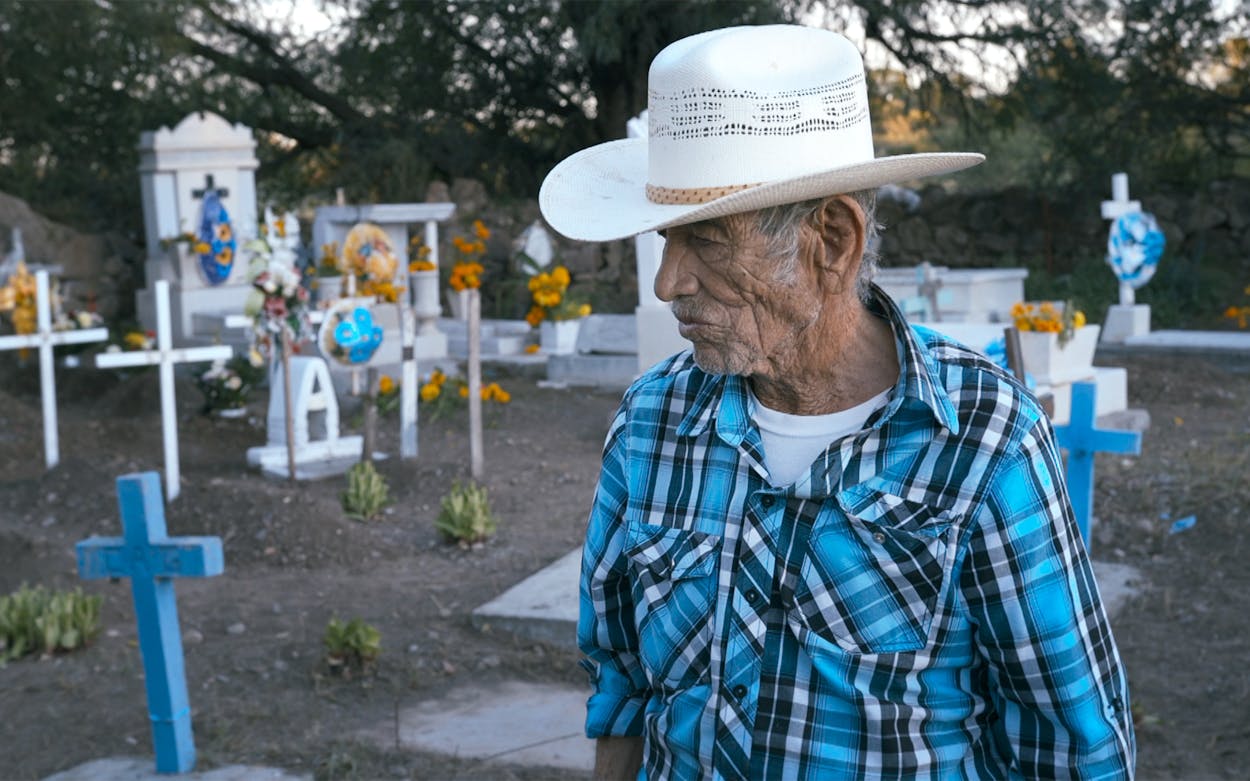When Iliana Sosa began filming in 2014, she started with a simple subject: her grandfather Julián and the monthly bus rides he’d take from his home in Durango, Mexico—566 miles south of El Paso—to see his children in the United States.
Over the course of seven years, she borrowed cameras, recorded scenes on her phone when she had nothing else, and eventually secured enough funding to hire a crew. With each passing year, the scope and ambition of her film grew: she captured her grandfather’s last bus ride, his declining health, and his final project—building a house where his family could visit him. What We Leave Behind, Sosa’s feature debut, is the strikingly intimate end result and the worthy recipient of the SXSW Louis Black “Lone Star” Award.
In the opening moments of the film, Julián is 89, resting on a couch in his daughter’s El Paso living room. He’s spent most of his adult life crossing back and forth between the U.S.-Mexico border, first as a bracero, traveling to work in the U.S. as a temporary laborer to support his seven children. Then, as they grew older and built lives for themselves in Texas and New Mexico, he made the journey as a father and grandfather.
Narrating in Spanish, Sosa recalls these visits in lively details—his smoking, the tamarindo and jamoncillo de leche candies he’d bring her, and the ever-present cowboy hat on his head wherever they’d go. As we watch the sun rise over the lavender sky in rural San Juan del Río, she shares the memory of her first trip to Mexico. “My mom crossed with me so I could meet my grandpa,” she says. “But I got sick, and I didn’t get better until I got back to the U.S. Ever since, Mom has liked to remind me, ‘You’d never make it over there.’ ”
Through these moments, What We Leave Behind conveys a feeling that many Mexican Americans know well—that disconnect between our lives here and our roots across the border. We may have history and family in Mexico, but when we or they visit, neither feels fully at home. For Sosa and her mother, Julián’s regular visits helped everyone feel whole. “From his stories to the little candies and food he’d bring us each month, my grandfather was always bringing that sense of home to us,” she told me. “Just his presence was enough.”
But when Julián grew too old to continue making the seventeen-hour trip, he pivoted his energy toward an even more arduous undertaking: building a guesthouse for his children and grandchildren. Brick by brick, the house begins to take shape during the film, and so does our knowledge of Julián’s life. Sosa gently peppers him with questions while he works, asking about his time as a bracero, the story of how he met his late wife, how he feels about death.
Complementing these moments is Sosa’s soft, inviting narration. She shares memories, family stories, and old legends her grandfather passed down to her. You can feel the tenderness in her camerawork. We see the everyday aspects of her grandfather’s life through her loving eyes. Even the most mundane things are captured with warmth, from the scratch of a razor against her grandfather’s stubble to the sizzle of eggs in a pan as he cooks her breakfast.
Other times, Sosa’s camera is so still that it feels like we’re looking at a stage play, or even a photograph. She places us in a moment, and we watch with a quiet reverence, taking everything in with her. Near the end of the film, Sosa uses this to beautiful, devastating effect. We see a frail Julián sleeping on a bed outside. He’s practically still as clothes hang on the line above him, moving gently in the breeze. Later, we’re in his bedroom, and Julián is surrounded by family members in his final moments, all of them huddled at his side in prayer.
“I didn’t want to film it,” Sosa told me. “But I wanted to show that there’s beauty in death. His family was there, with the exception of my family members that are undocumented. No one left his side. That’s something special that not everyone has. That kind of life should be celebrated.”
So much of Sosa’s film takes on a double meaning. Mentions of “the other side” conjure up imagery of both the afterlife and the border. Even the film’s title serves more than one purpose. There are the things we leave behind in death: our belongings, our families, and also our stories. And for families like Sosa’s that exist on either side of the Rio Grande, something is left behind with each crossing. In the last minutes of the film, Sosa illustrates Julián’s absence by walking around his house, panning over empty spaces and grieving family members.
In Sosa’s film, I saw the final year of my grandfather’s life. Like Julián, he was a strong-willed Mexican man who was always better prepared for his own death than the rest of us. Seeing Julián on his deathbed, I bristled at first, not only because it brought up painful memories, but because it felt like an intrusion. Seconds later, though, struck by how visually similar the scene was to my grandfather’s final days in hospice, I softened. That memory I’d had, one so isolating and heartbreaking, had transformed into something new.
Perhaps it felt strange to watch Sosa capture these moments because we never talk about them. Maybe if we saw them and recognized the beauty of a long life full of stories, of hardship and of love, maybe death wouldn’t be something to fear after all.
“My grandfather saw death as something we were all in line for,” Sosa told me. “There was no romanticizing because he looked at life differently. He raised seven kids, traveled across the border; he just had to keep moving.”
- More About:
- Film & TV
- Documentary
- El Paso








